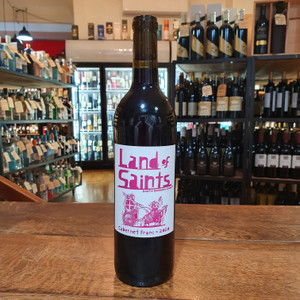
While stocks last. An extra special discount for Xmas. A leading single-vineyard red from a natural Cabernet Franc producer in the Loire Valley. Les Peuilles is a special site for this small family operation, a "lieu dit" on a pleateau near the village of Beaumont-En-Véron, where the soils are of flinty clay rather than limestone. The grapes are hand harvested then fermented naturally, after which they spend 6-12 months on traditional large format vessels of old oak and chestnut. With a subtle generosity but plenty of poise and minerality, the Les Peuilles can be drunk on release, or for decades afterwards. What a delight!
Olga Raffault
"Domaine Olga Raffault is unquestionably one of the long-time reference points for top-quality, traditional Chinon wines. Its history is intriguing. Olga and her husband Pierre operated the estate together until he died unexpectedly just before harvest in 1947. Alone with two small children, Olga was left to run the business but was ably assisted for the vintage by employee Ernest Zenninger, a German prisoner who had found refuge and work at Raffault at the end of the war. Ernest stayed on, becoming the winemaker and working closely with Olga’s son Jean Raffault. The two of them ran the estate as a team for decades, under Olga’s watchful eye, until Jean’s daughter Sylvie and her husband Eric de la Vigerie took over about 10 years ago. The farming is certified organic and harvest is manual. This minimalist approach in the vineyard extends to the cellar. The fruit is de-stemmed, with the whole berries going uncrushed into tank for fermentation with native yeasts." (Bowler Wine)
Cabernet Franc
Cabernet Franc is a dark-skinned French wine grape variety. The variety is most famously known as the third grape of Bordeaux and can be found in many of the world's top Bordeaux blend wines.
Cabernet Franc is commonly compared to Cabernet Sauvignon, which is not surprising as it, along with Sauvignon Blanc, is a parent of Cabernet Sauvignon.
Chinon
AOP/AOC by decree dated 31st July 1937, amended 17th August 2016
VINEYARDS
Location: The Chinon appellation encompasses 26 communes on both sides of the Vienne up to the point where it joins the Loire.

Vineyard Area: 2,310 ha.
History: Over the years, the Royal Fortress of Chinon overlooking the Vienne has played host to countless kings and princes, from the Plantagenets to Richelieu. In 1429, Charles VII received Joan of Arc here; her mission was to convince him to reconquer the Kingdom of France. François Rabelais was born here, and the appellation closely follows the boundaries of La Rabelaisie, the mythical land of Pantagruel and Gargantua. Chinon is popular with visitors who flock to see this Rabelaisian vision etched into Chinon’s architecture and landscapes.
Soil: There are three major soil types:
- Alluvial terraces (ancient and recent) along the banks of the Vienne, comprising gravel and sand.
- Turonian (yellow tuffeau) limestone outcrops where the rivers meet.
- Plateaus and hillocks largely made up of siliceous clay and sand
Climate: The confluence of the Loire and Vienne marks the start of mild Atlantic conditions. The oceanic climate sweeps through the two valleys, reaching the most distant hillsides and terraces. Slopes are oriented east to west, enjoying excellent, sunny southern exposures; the microclimate is ideal for growing Cabernet Franc.
WINES
Average Annual Production over the last 5 years:
Whites: 2,300 hl,
Reds: 72,600 hl,
Rosés: 10,300 hl
Base yield: 55 hl/ha.
Varietals: Reds and rosés are made almost exclusively from Cabernet Franc (Breton), although Cabernet Sauvignon is authorised to no more than 10% of the varietal mix. Whites are made from Chenin.
Growing Practices: Minimum planting density: 4500 vines per hectare
TASTING NOTES
Appearance: Chinon reds are intensely coloured, initially lively cherry-red to deep garnet, developing a hint of tawny and a glimmer of purple.
Nose and palate: Some wines are light and delicate with pronounced scents of red fruit and very pleasing when young; others are more robust and structured, developing complex flavors of cooked black fruit, baking spices and game. Many winemakers offer a range of products from a variety of terroirs. Chinon white is also made, but in smaller quantities. These are the ‘taffeta’ wines extolled by Rabelais, often silky smooth with a mineral tang.
Serve young wines at 14-15°C, older ones at 16-17°. Decanting is recommended in both cases – to soften a young wine and to allow an older one to open up.
FOOD PAIRINGS
Young, fruity reds pair well with grilled meats, white meat or eggs in wine sauce. The most structured wines call for richer foods such as braised beef or game, meat in mushroom sauce, squab or other game dishes.
AGEING POTENTIAL
Depending on style, Chinon wines reach their peak between 2 and 5 years or 10 and 20 years.







